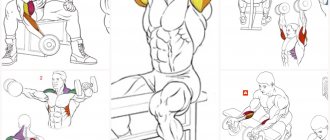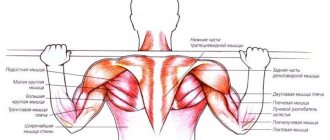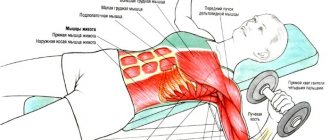Number of approaches in different sports[edit | edit code]
Source: "Training Programs"
, scientific ed.
Author:
Professor, Doctor of Science Tudor Bompa, 2020
An approach
is the number of repetitions of an exercise followed by a rest break. The number of approaches depends on the number of exercises and strength combination. The number of sets per exercise decreases as the number of exercises increases, because otherwise the volume of the workout will become too large. In addition, there is an inverse relationship between the number of repetitions in a set and the number of approaches in an exercise. For example, for a rower, canoeist or skier looking to develop long-term muscular endurance, the key element is the number of repetitions per set. Because the number of repetitions is high, it is difficult for these athletes to perform more than three sets.
The number of approaches also depends on the ability and trainability of the athlete, the number of muscle groups being developed and the stage of training. For example, a specialized program for a high jumper or diver may include three to five exercises with four to six sets of each exercise. When increasing the number of exercises, it is necessary to reduce the number of approaches, which will be accompanied by obvious disadvantages. As an example, consider a high jumper who performs eight exercises that work different muscle groups in the legs, upper body, and arms. The amount of work performed by an athlete during each exercise or for each muscle group is about 400 kilograms. Since the athlete can only perform four sets, the total amount of work for the muscle group will be about 1600 kilograms. However, if the number of exercises is reduced to four, the athlete can perform a total of, for example, eight approaches, and the total volume of work will be about 3200 kilograms per muscle group. In this way, an athlete can double the total amount of work performed by the prime mover muscles by decreasing the total number of exercises and increasing the number of sets.
The number of sets performed during a training session also depends on the stage of training. During the preparatory (pre-season) stage and, in particular, during the anatomical adaptation stage, when most muscle groups are trained, the bulk of the exercises are performed with fewer repetitions. However, as the competition phase approaches, the training becomes more specific and the number of exercises decreases along with the increase in the number of sets. Finally, during the competitive phase (season), when the goal of training is to maintain a certain level of strength or a given combination of strength, both the number of exercises and the number of approaches are reduced so that the athlete's energy is spent more on technical-tactical work or specific training .
In team sports where the competitive season is long, the athlete performs only a few sets per exercise (two, three, maximum four) in order to reduce residual fatigue and the likelihood of a negative impact on the recovery process and specific performance. On the other hand, a well-trained individual sport athlete may perform three, six, or even eight sets. Of course, it makes sense to perform a large number of approaches. The more sets an athlete performs on an exercise that plays a fundamental role in the development of prime mover muscles, the more work the athlete can perform, ultimately resulting in greater strength gains and improved performance.
Simple difference
Beginning athletes often confuse the concepts of repetitions and sets, passing them off as one and the same thing. In fact, the meaning is different. Repetition is considered to be performing a load once. For example, one pull-up or squat. As for what approaches in exercises are, this is the number of repetitions that a person performs without a break or rest.
The optimal number of repetitions in one approach depends on the athlete's level of physical fitness and endurance. The type of exercise also plays a role. For fat-burning workouts, experts advise doing more repetitions per approach and increasing their number (20 repetitions in 1 approach). To pump up muscles, the number of approaches for muscle regeneration increases, but the number of repetitions decreases.
To increase endurance, trainers advise doing 15 repetitions for 3-4 approaches for one exercise. To build muscle mass, another important indicator is taken into account in the form of time; the faster the load is performed, the better.
How many approaches to do per muscle group[edit | edit code]
Author: Dmitry Yakovina
Bodybuilding as a body development system has existed for more than 60 years, but, nevertheless, there are elements in this system that cannot yet be called perfect. In particular, there is still some uncertainty with such an important parameter of the training process as the number of working approaches (sets) performed per muscle group per workout. Yes, no one does 100 sets, no one does 50, 40, 30 or even 20. But as for smaller numbers, there is a clear scatter.
Many authoritative methodologists often express diametrically opposed opinions. Just look at HIT by Arthur Jones and his follower Mike Mentzer (you can also include Dante Trudel with his Doggcrapp system here), who claim that literally one working approach is sufficient for effective muscle growth, as opposed to traditional high-volume training, including 8-16 approaches. However, since we are not equal in our capabilities, we cannot categorically recommend the same thing to everyone. As much customization as possible is required. And in order to do this, it is necessary to identify the criteria by which such adjustment will be carried out.
How many approaches per workout?
Intermediate bodybuilders do 25-30 sets per workout. When beginners come to me, many of them get very tired after 15 approaches.
Also, the number of approaches per workout depends on the intensity of the approaches and the purpose of the workout itself.
The higher the intensity of the approaches, the smaller their number. There are people who like to come to training for several warm-up exercises and one working approach to failure.
I adhere to the classical school of strength training with an intensity of up to 90% and a volume of about 30 sets per workout.
Level of training[edit | edit code]
The traditional approach described in Joe Weider’s “Body Building System” is based on the fact that beginners only need to perform 1-3 sets per workout per muscle group, but the workout itself should be repeated quite often - every 2-3 days, in particular this is provided by the circuit program full body workouts. Then, as your training level increases, the volume of load should increase and the frequency of training should decrease.
So, after training for the whole body, the transition is made to training half of the body at a time, that is, half of all muscle groups being developed. This can be seen in a two-day split. The load volume increases to 4-6 sets, and the frequency of training is reduced to once every 4-5 days. And subsequently, a more prepared athlete switches to a classic weekly split, which provides for 9-12 approaches per muscle group in one workout and this training is repeated once a week.
The logic of such a change in volume/frequency is that beginners, due to their lack of training, respond perfectly to a very small volume of load and, for example, performing three sets leads to the maximum possible adaptation in the form of hypertrophy and an increase in neuromuscular conductivity, that is, with an increase the volume of load, the return from training will not become higher. And taking into account the small amount of work on one muscle group, the negative changes that occur in it during the process of fatigue, for example, the destruction of muscle cell organelles under the influence of hydrogen ions, are insignificant, which makes it possible to repeat such a load quite often, each time again spurring protein synthesis.
It is much more difficult for a more experienced athlete to bring his muscles out of balance in order to cause intense progress. In practice, we can all observe this. The more experienced the athlete, the less return from his training. A beginner can easily increase his strength levels by 100% in a year and gain 15 kg of muscle mass during this period. And athletes with 10 years of experience are happy with even one kilogram of muscle per year. For this reason, as the level of training increases, the level of metabolic stress caused by the load should also increase, as well as the degree and volume of mechanical stress.
It is no coincidence that professional bodybuilders predominantly practice a constant tension regime, in which exercises are performed in a limited amplitude without muscle relaxation. This is the only way to create the most severe acidosis - “acidification” of muscle cells. And although there is no research that would confirm that this regime is most effective for experienced athletes, widespread practice suggests that this is most likely the case. For this reason, increasing the volume of the training load as the athlete's experience increases is justified.
Lane Norton, an authoritative trainer, athlete and scientist, also agrees that beginners need to perform fewer sets and increase their number as their training increases.
For beginners (up to a year of experience) he recommends 2-4 approaches per workout, advanced (1-3 years of experience) 4-6 approaches, experienced (3-5 years) 6-8. He considers increasing volume as experience increases a necessary condition for further progress, since at first an increase in working weights will be enough to achieve hypertrophy, but working weights cannot grow indefinitely and an additional volume of load will help in this case to bring the muscular system out of balance .
However, Arthur Jones and his followers believe somewhat differently. With experience, not only the frequency of training should decrease, but also the volume of load on one muscle group and the workout as a whole:
- Beginners
: 3 times a week, 16–20 sets in total for the whole body. - Experienced
: 2 times every 5–7 days, 12–15 sets in total for the whole body. - Very experienced
: 1 time every 5-7 days, 8-12 sets in total for the whole body.
The essence of this is that with experience, the working weights used increase, and therefore the effect on the muscular system and on the body as a whole. The limited volume of the load is thus compensated by the severity of the effort applied.
There is a certain logic in such recommendations. But in practical terms, such a radically low volume does not occur. There are examples where high-level athletes perform significantly fewer working approaches than everyone else (at level 5-7), but this is far from one, two or three sets, as recommended by VIT and at least twice as many as the traditional system recommends for beginners .
Types of sets in training
Depending on the purpose and final goal, sets are divided into several varieties.
A superset means several exercises designed to simultaneously load and target opposite muscle groups, while the exercises are performed without a break between sets.
There is often confusion between supersets and complex approaches . The difference is that the former targets opposite muscle groups, while the latter targets the same group.
A two-set is a pair of exercises aimed at one muscle group; like a superset, it is performed without a break.
Next up is the drop set . This is when the weight is reduced on each approach, for example 35 then 30, and finally 25, but each subsequent time the number of repetitions increases. Due to this, accelerated muscle growth and endurance training are achieved.
The drop set is aimed at increased intensity, and therefore you need to judiciously calculate your endurance.
“rest-pause” set is when you take the maximum weight, counting on 2-3 repetitions, then a short rest without leaving the rack, and everything is repeated. Focused on strength training.
Different grips. Typically used for one muscle group, with a forward and reverse grip without a break between different grips as one set. Usually used once, not more often.
When after performing the exercises there is not enough strength, then a forced set
This means doing reps with the help of a trainer. Also used in bodybuilding.
Cluster sets follow . These are two exercises for one muscle group, performed with a pause between approaches. Works great for hypertrophy.
Approaches with variable load do not require poor health. The bottom line is that during the process, without interrupting the exercise, gradually increase the load on the bar. Over the course of seven to eight repetitions, the weight is increased, and then the partner or trainer also removes it in several stages, while the exercise continues.
Training frequency and number of sets[edit | edit code]
The more often we train the same muscle group, the fewer approaches we should perform at a time. This recommendation is found quite often, moreover, it forms the basis of training the whole body at one time - “fulbadi”, two-day split, the HIT system and Dogcrapp.
Why do 99% of those who train do not one, not two or three approaches per muscle group, but more? Because it brings results.
As sports science says, the greater the load on muscle fibers, the more growth factors are formed in them, the more anabolic hormones penetrate into them. For those unaware, at rest, up to 90% of all testosterone circulating in the blood is unable to penetrate muscle fibers, but the opposite is true under optimal physical activity.
We literally pump testosterone into muscle cells, performing set after set (although for “natural” athletes this is not as important as for “chemists”, since “natural” athletes have very low testosterone levels and its fluctuations in response to load are not significant - limit 10-30%). Once inside, the latter begins to actively stimulate protein synthesis, which leads to its utilization. The only thing that stops us from repeating high-volume training every day is that doing many sets will not only pump a lot of hormones into the muscles, but also cause a high accumulation of hydrogen ions in them.
Hydrogen ions are not only a growth factor, but also a powerful catabolic factor.
If you do not wait until the muscle has more or less recovered and subject it again to a similar load, then the catabolism caused by hydrogen ions will cancel out the results of the previous load, as it will destroy the resulting protein structures that have not formed into full-fledged myofibrils. Catabolism must be dosed both in magnitude and frequency.
And here the logic of high-frequency training of one muscle group with a small volume of load on it begins to emerge. More frequent training more often releases anabolic hormones into the muscles and more often stimulates protein synthesis due to local growth factors and activation of signaling systems.
If you do not wait until the muscle has more or less recovered and subject it again to a similar load, then the catabolism caused by hydrogen ions will cancel out the results of the previous load, since it will destroy the resulting protein structures that have not formed into full-fledged myofibrils.
At the same time, a small volume of load, although it will not “let in” many hormones into the muscle cell and does not stimulate protein synthesis to the maximum extent, will not cause pronounced catabolism. So what is better in practice: do a lot of sets on a muscle and let it rest for 7 days, or do several sets, but two or three times a week? There is probably no point in blindly listening to the opinions of athletes, coaches and methodologists, since each of them will defend their usual training scheme.
However, there is a clear trend in recommendations that are addressed to athletes who do not use anabolic steroids. Most reputable experts insist that a “natural” should train more than once a week and the volume of training should be limited!
Thus, the most famous nutritionist in the world of sports, Lyle MacDonald, says the following: “You need to train a muscle group at least twice a week. A top-bottom split of Monday, Tuesday, Thursday and Friday will be optimal for most. Full body workouts twice a week are also good. Leave training each muscle group once a week to the genetic elite or those who use steroids. When in doubt, always reduce the volume, but do not increase it.
Despite magazine articles, you don't need a million sets for hypertrophy. If you can't get a muscle group to grow from 4-8 heavy sets, it's time to stop training like a weakling."
Similar recommendations regarding the frequency of training are given by the previously mentioned Lane Norton, a famous trainer, bodybuilder, powerlifter and scientist who promotes natural training: “it has already been scientifically proven that the paramount importance is not single, but repeated training of each part of the body throughout the week . I've found this to be true...Training each body part once a week can be effective for beginners, but I believe that over time, training twice a week will increase muscle strength and size much more."
American sports scientist Michael Thomas, in the process of writing his doctoral dissertation entitled “Increasing muscle mass and strength: a comparison of high and low frequency strength training,” conducted studies involving seven women and twelve men with at least several years of training experience. He divided the study participants into two groups. One group performed a traditional weekly split, in which muscle groups were distributed by day of the week as follows:
- chest + shoulders + triceps (Monday),
- back + biceps (Wednesday),
- legs + calves (Friday).
During the workout, participants performed 9 sets for each muscle group of 8–12 repetitions.
The second group trained all of the listed muscle groups per workout, but did 3 sets of 8-12 repetitions.
There were three such training sessions per week: on Monday, Wednesday and Friday. After 8 months, Michael Thomas measured gains in muscle mass and strength in both groups. Participants in both groups showed progress, but there were no statistically significant differences. Both of them progressed equally. That is, the pattern of frequent training with a limited volume was effective, but no more effective than a traditional split training one muscle group once a week. What if the participants trained as MacDonald recommends, 2 times a week for 4-8 sets?
Unfortunately, there are no such studies, but it is worth listening to the opinion and experience of this sports physiologist. At least what he says is logical. Limited volume of load on a muscle group with a higher frequency of training. Only your personal practice will show how effective this is.
an approach
AN APPROACH
I.
A completed or unfinished competitive exercise in gymnastics, powerlifting, and weightlifting (if the barbell is raised above knee level). The time (90 s) during which the athlete did not enter the platform after being called by the competition secretary is also considered an approach.
- additional approach. An approach to the bar that does not count toward the competition result. Given to an athlete when attempting to break a record.
- credit approach. An approach whose result counts towards weightlifting and powerlifting competitions. Athletes of III, youth categories and beginners have the right to 5 qualifying approaches, athletes of II category - 4, all others - 3.
— the approach used. Any approach to the barbell - successful or unsuccessful, as well as overdue set time for the approach.
- approach to breaking a record. The approach of a weightlifter or powerlifter in official competitions to a barbell with a record weight in qualifying attempts (counts as the result of the competition) or in additional attempts (does not count as the result of the competition).
- trial approach. An approach that is given to weightlifters and powerlifters on the competition platform and is not taken into account in competitions if the warm-up conditions do not allow lifting a lot of weight.
- warm-up approach. Exercise with a barbell before entering the competition platform.
II.
Actions of the athlete before starting the exercise. In artistic gymnastics, the athlete moves from standing at attention until he jumps on the apparatus before performing the exercise. For an unclear approach, a certain part of the score is deducted from the participant’s score.
III.
Approximation.
- the horse's approach to the obstacle. The optimal angle of approach for a horse to an obstacle, at which it is easier for him to calculate the jump, is straight. We must try to direct the horse to the middle of the obstacle. The horse only slows down when jumping down. Jumping from a diagonal turn requires special training, courage and trust between the horse and the rider.
— the swimmer’s approach to the turn. Actions of a swimmer performed 5-6 m before a turn, when he must calculate his swimming movements in such a way as to perform the turn most efficiently, without reducing speed.
IV.
In bodybuilding, weightlifting, and powerlifting, the completed number of repetitions of a single training exercise.
(Terminology of sports. Explanatory dictionary of sports terms, 2001)
Source: Dictionary of sports terms on Gufo.me
Meanings in other dictionaries
- approach - See approach Dahl's Explanatory Dictionary
- approach - -a, m. 1. Action according to the verb. fit (in 1 and 3 digits). With a deft approach with a jump and tilt of his head to the side, Chichikov completely charmed the St. Petersburg lady. Gogol, Dead Souls. Small academic dictionary
- approach - noun, m., used. compare often (not) what? approach, what? I'm approaching, (I see) what? approach, what? approach, about what? about the approach; pl. What? approaches, (no) what? approaches, what? approaching, (see) what? approaches, what? approaches, about what? about approaches... Dmitriev’s Explanatory Dictionary
- approach - APPROACH, a, m. 1. see approach. 2. A place where one approaches something. Convenient point to the crossing. 3. A set of techniques, methods (in influencing someone, in studying something, in conducting a business). Correct point to the point. You need to be able to find a person. | adj. suitable, aya, oe (to 2 meanings). Ozhegov's Explanatory Dictionary
- approach - Approach, approaches, approach, approaches, approach, approaches, approach, approaches, approach, approaches, approach, approaches Zaliznyak's Grammar Dictionary
- approach - Under / move /. Morphemic-spelling dictionary
- approach - approach m. 1. Process of action according to ch. approach 1. 2. Place, path along which they approach, approach something. 3. The way of treating someone, something, the nature of the attitude towards someone, something. || decomposition A trick, a trick. Explanatory Dictionary by Efremova
- approach - ENTER - EXIT owls. enter - exit Entrance - exit (see) entrance - exit (see) incoming - outgoing (see) in (o) descend - enter (see) sunrise - sunset (see) ascend - descend (see) ascending - descending (see) approach - depart (see Dictionary of antonyms of the Russian language
- approach - APPROACH, approach, male. 1. units only Action under Ch. come in 1, 3, 4 and 5 digits. - suit. The train approaches the landing stage. 2. A place where one approaches something. Swampy approach to the river. On the approaches to the station. Ushakov's Explanatory Dictionary
- APPROACH - APPROACH - a complex of paradigmatic, syntagmatic and pragmatic structures and mechanisms in knowledge and/or practice, characterizing competing (or historically replacing each other) strategies and programs in philosophy, science... The latest philosophical dictionary
- approach - noun, number of synonyms: 16 anthropodicy 1 road 97 access 15 organismism 1 approach 9 approaches 8 approach 14 approach 17 approach 32 passage 64 path 63 method of address 1 simplification 8 simplification 7 leveling 3 move 94 Dictionary of synonyms of the Russian language
- approach - orf. approach, -a Lopatin's Spelling Dictionary
- approach - APPROACH -a; m. 1. to Approach (1, 3 digits). Wait for reinforcements to arrive. 2. A place where one approaches, one can approach something. Convenient location to the river. 3. A set of methods, techniques in considering something, in influencing someone, something. and so on. Scientific… Kuznetsov’s Explanatory Dictionary
- Blog
- Jerzy Lec
- Contacts
- Terms of use
© 2005—2020 Gufo.me
Quality of exercises[edit | edit code]
When we talk about a particular number of working approaches, we a priori mean that each of them is performed with the correct technique and to failure. In the absence of these conditions, trying to give a clear answer about the required level of load volume is even more difficult. Obviously, the value of one approach performed not to failure is significantly lower than to failure. If an athlete is able to perform an exercise with a weight of 100 kg 15 times, but does only 10, then the changes occurring in the muscle cell will be clearly insufficient to stimulate the maximum possible hypertrophy.
In this case, in order to accumulate the beneficial effects of the load on the muscular system, you will have to perform much more approaches than if they were extremely heavy. The less local fatigue a set causes, the more such sets should be performed. A typical example is the training of amateur girls. Women, by nature, perceive rejection differently than men. As soon as it becomes more or less difficult for them, they stop doing the exercise. Then literally a minute later they do it again, since there was no particular fatigue.
For this reason, trainers can safely “prescribe” their female wards 12-16 approaches per muscle group without the risk of excessive catabolism and overtraining.
Incorrect exercise technique leads to the fact that the target muscle group does not receive the proper load during one approach. In such situations, the athlete usually does not feel “pumped up” and “clogged” in the muscle that the exercise is aimed at. As an example, perform the exercise “dumbbell row to the belt in an inclined position.”
A careless athlete takes too much weight and is unable to perform a deadlift using only the latissimus muscle, and begins to rotate the torso using the core muscles. The dumbbell rises higher, but the degree of participation of the latissimus muscle in the exercise is not great; failure occurs, but not due to its fatigue. Accordingly, the value of such approaches is not great.
Therefore, you have to repeat them until the muscles receive the necessary fatigue. Technical errors are different, but sometimes they are caused not by the technique of the exercise, but by the anatomical characteristics of the athlete.
That is, an exercise that suits the majority is not suitable for a particular athlete. With a height of two meters, it is very difficult to perform squats in a more or less acceptable amplitude without transferring the load from the legs to the back. Tall athletes, when squatting with a barbell, often simply “fold” and their back is the first to fail, not their hips. Therefore, two or three such sets of squats do not stimulate the growth of the thigh muscles. The greatest number of technical errors or inappropriate exercises can be found among complex, multi-joint movements with free weights.
It is more difficult to make mistakes with machines or single-joint exercises.
Lyle MacDonald's words "If you can't get a muscle group to grow from 4-8 heavy sets, it's time to stop training like a weakling" in relation to this situation could be supplemented with the following: "...it's time to stop training like a weakling, with incorrect technique in exercises that are not suitable for you."
Rules for performing warm-up approaches
1. The first warm-up set (even if it is the last) should be with a weight of NO MORE than 50% of your one-rep maximum. That is, if you bench press 100 kg for 1 rep, then the first warm-up should be a MAXIMUM of 50 kg.
2. Warm-up approaches should be done immediately before a particular exercise, and not in bulk at the beginning of the workout. The exception is the circular method. There you need to do warm-ups en masse at the beginning. BUT! In the circular method, as a rule, the weights on the equipment are small.
3. The technique for performing warm-up approaches should be the same as for workers. That is, it is a bad idea to squat with a wide stance during the warm-up, and with a narrow stance during the working approaches.
4. Rest after warm-up approaches should be 1.5 - 2 times less than after work sets. For example, if after work you rest for 2 minutes, then 1 – 1.5 minutes of rest is enough.
5. Number of repetitions. There are no exact numbers here, but I voiced the basic rule at the beginning: the number of repetitions should be significantly lower than the maximum. Typically, the lighter the weight, the more repetitions. And as you approach the working weights, the number of repetitions decreases. On average this is 8 – 12 repetitions. However, in warm-up sets the number of repetitions may well be less than in working sets. This is usually observed in more trained people.
Presence or absence of pharmaceutical support[edit | edit code]
A number of methodologists insist that those trying to build muscle mass without the use of steroids should limit themselves to a small number of approaches per muscle.
Prolonged intense exercise leads to the destruction of the protein structures of muscle cells, which can lead to the fact that during training we will destroy more than we are able to build during the recovery process. That is, training will not lead to an increase in new muscle volumes. Athletes using steroids receive a much greater benefit from training in terms of stimulating hypertrophy, which allows them to ensure a significant predominance of protein synthesis over breakdown. That is, the risk of going overboard with the load is less for a “chemist” than for a “natural” person.
There is logic in this, but there is no specificity and there cannot be. Obviously, a “naturalist” should do less work than a “chemist,” but even among chemists, the number of approaches per muscle group is different. Some successfully grow from 5-7, others from 10-14. What is there to start from? Popular in his time author of the book “Think. Bodybuilding without steroids" Stuart McRobert promoted abbreviated programs consisting of one to five approaches per muscle group.
Lyle MacDonald recommends doing 4-8, Lane Norton 6-8. We can see in these examples that the upper limit is indeed limited (no one recommends more than 8), but the lower limit is different for everyone. Perhaps, one approach is still not enough, such a volume is enough only for a beginner, but an experienced athlete needs to do at least 3-4 approaches to achieve noticeable stimulation of hypertrophy. Almost all studies on this topic have shown that three approaches are better than one.
For a “chemist,” such a small amount of load may also be enough, and there are many examples of this in practice, but the majority still performs a larger number of approaches (8-12) and grows successfully. Again, the quality of each set is equally important, as discussed above.
Perhaps, one approach is still not enough, such a volume is enough only for a beginner, but an experienced athlete needs to do at least 3-4 approaches to achieve noticeable stimulation of hypertrophy.
When should you do warm-up sets?
There is no answer to this question. Everyone decides for themselves in each individual case. I can only say that it depends on:
1. Your fitness level. As a rule, the higher it is, the fewer warm-up approaches there may be, or sometimes they are not needed at all (all other things being equal). More often than not, this is true, but not always.
2. Projectile weights. For example, it's obvious that if you're squatting 300kg, you'll need more warm-up sets than someone squatting 70kg. And if you are a beginner and are going to squat with an empty bar, then why do you need a warm-up approach at all?
3. Injuries and pain. If you are going to do an exercise that causes joint pain, then you may need a warm-up approach even where no one ever does it.
4. The exercise itself. The more basic the exercise, the greater the need for a warm-up approach. For example, with barbell squats, almost everyone needs a warm-up set (or several). But when extending the legs in the simulator, most people do not need a warm-up approach. It also depends on the risk of injury of the exercise. For example, lying dumbbell flyes are an isolating exercise, but quite dangerous. Therefore, in most cases it requires a warm-up.
5. Previous exercises. For example, if you do the leg press as your very first leg exercise, you'll likely need a warm-up set (or several). But if you have already squatted with a barbell before the leg press, then your muscles and joints on your legs have already warmed up and in this case, a warm-up may no longer be necessary.
Ultimately, the need to warm up depends on the combination of all these factors. That is, for example, it does not mean that a warm-up is not needed in all isolating exercises, but that it is necessary in all basic exercises. You need to look at all these 5 factors and decide on the amount.
In this case, the number of warm-up approaches can be from one to infinity. This is influenced by exactly the same factors that I just cited. But, as a rule, 1 or 2 such approaches are enough for amateurs. Less often - 3.
Conclusions[edit | edit code]
Thus, based on all of the above, we can summarize that it is impossible to “diagnose a patient without knowing the medical history,” that is, you cannot simply recommend doing a specific number of sets without taking into account many criteria. The individual approach dominates in bodybuilding. If you are not a genetically gifted monster who grows from everything you do in the gym, then you need to focus on the following criteria for choosing the volume of load on a muscle group:
- level of training (training experience) – the higher the experience, the more approaches we need
- frequency of training one muscle group in a microcycle - the more often we train, the smaller the volume of one workout should be
- quality of exercises - the less return from the approaches, the more they need to be performed
- presence or absence of pharmaceutical support - the less pharmaceutical support, the more careful you need to be with the amount of load on each muscle
Myth #2: Each exercise should have 3 sets.
With such a load you will always progress, there is simply no point in doing more.
Origin of the Myth: In 1958, a report by Thomas Delorme stated that 3 sets of 10 reps would be no different in effectiveness than 10 sets of 10 reps.
Disclaimer: This is not true. Believe me, your muscles don’t care about the magic of the number “3”. You should know only one rule: the more repetitions in a set, the fewer approaches. That is, in general, the number of repetitions remains approximately the same, only the number of divisions into sets changes.
Bottom line: Average weight? - 3 sets of 8 repetitions. Do you lift heavy weights and do 3 reps? – perform 6 sets.
How many sets of the exercise should I do?[edit | edit code]
A useful rule of thumb:
Do as many sets as necessary to complete at least 25 reps for the muscle group of your choice. If you're planning on doing a set of 5 reps, you'll need to do five sets. If the set consists of 15 repetitions, then you will need to do two sets. The more repetitions of an exercise you do, the fewer sets you need to perform, and vice versa. This will allow you to keep the muscles under tension for the appropriate amount of time for any repetition range.
If you are in good physical shape, you can easily perform more than 25 repetitions per muscle group. However, exceeding the 50 repetition limit is not recommended. For example, the general recommendation for bodybuilders is this: for one muscle group, perform 3-4 exercises, 3 sets of 10 repetitions. This gives a total of 120 reps per muscle group. The problem is that if you're doing about 100 reps for each muscle group, you're not working hard enough. Approach this issue from this angle: the higher the load, the shorter period of time you can withstand it at a given level. For example, many people can run at a slow pace for an hour, but you are unlikely to find someone who can maintain a sprint pace for that long. And if you start to get tired, it means the muscle group you are working with has received sufficient load. So why waste time doing extra reps?
Why are warm-up approaches needed?
1. Reduces the risk of injury. This occurs due to warming up and stretching of joints and muscles under a small, but still load.
2. Increasing the effectiveness of working approaches. The fact is that after warm-up approaches, muscles are able to develop greater strength, since they are better stretched and better filled with blood.
3. Improving exercise technique. This point is relevant mainly for beginners. With a small weight it is easier to learn and consolidate the exercise technique.
Read also[edit | edit code]
- How to determine working weight
- How often to exercise
- Training Volume
- Optimal training duration
- Order of exercises
- Gradual increase in load
- How many repetitions to do in a set
- How long to rest between sets
- How many times a week to train
- How many exercises to perform for one muscle group
- Exercise speed
- Number of repetitions for mass and strength in the exercise
- Number of approaches per muscle group
- Strength Training Intensity
- Rest between exercises and sets
- Rest between sets
How many sets and reps?
The number of sets of strength exercises depends on the intensity of the sets and your resources for recovery.
If you have enough quality food and good sleep, then the number of approaches can be large and this will benefit your body.
The number of repetitions per set depends on the goal of the training. Strength training typically has two goals: gaining muscle mass and increasing strength.
Create a training program for free
Myth No. 3. You need to perform 3-4 exercises for each muscle group.
This is the only way you will efficiently load a specific muscle.
Origin of the Myth: Arnold Schwarzenegger's Postulate (1966).
Refutation: the same Arnie said that each exercise should be performed 8-12 times in 3 approaches. After average calculations, there are almost one and a half hundred repetitions for each muscle group. If you are able to withstand such a load, you are hacking. It is better to make training less voluminous, but more effective. Moreover, working on such advice, your training will take a lot of time, not everyone can handle it.










